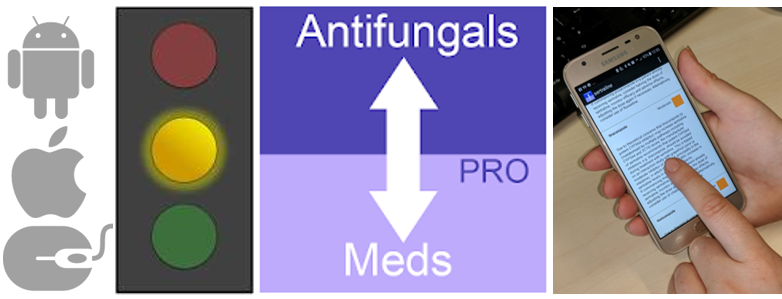An up-to-date list of treatment guidelines is available to help with management of individual patients, or you can find detailed information about different antifungals and other treatments using the links below.

Antifungal drugs
The range of antifungals available to treat a given infection is often limited by cost, local approval, or by increasing rates of antifungal resistance. It is vital that more research is carried out to discover new classes of antifungals, as well as to optimise delivery systems to minimise the side-effects caused.
- Read a method for instilling amphotericin B directly into an aspergilloma cavity
- Read more about side effects and how to minimise them.

Other types of treatment
While oral antifungals are the mainstay of managing most patients with serious fungal infections, some conditions may be suitable for surgery or immunotherapy. Other treatments (especially oral corticosteroids) are required for allergic conditions such as ABPA where the body over-reacts to the presence of fungi, although antifungals may play a role in reducing the fungal burden of the patient. Unfortunately no vaccines are currently approved for fungal conditions, but several are in development.
For self-care tips (including coping with side effects of antifungals) you may wish to direct your patient to the Aspergillosis Patients & Carers website.

Obesity Dosing Tool (adults only)
| Antifungal | Standard daily dosing in adults | Loading dose | Renal dysfunction | Liver dysfunction | Age >75 years | Obese | Morbidly obese |
| Itraconazole | 300-600mg@ | Yes, if very ill | No change# | Avoid | No change@ | No change | No data |
| Fluconazole | 200-1200mg | No | Reduce | No change | No change | Use AdjBW | Use AdjBW |
| Voriconazole | 300-600mg@ | Yes | No change# | Reduce or avoid | Lower dose@ | Use AdjBW@ | Use AdjBW@ |
| Posaconazole | 300mg | Yes, if very ill | No change# | No change | No change | No change | No change |
| Isavuconazole | 200mg | Yes | No change | No change | No change | No change | No data |
| Liposomal amphotericin B | 3mg/Kg | No | No change* | No change | No change | 300mg | 300mg |
| Caspofungin | 50mg | Yes | No change | Reduce | No change | 70mg | 70mg |
| Micafungin | 100-150mg | No | No change | No change | No change | 150mg | 150mg |
| Anidulafungin | 100mg | Yes | No change | No change | No change | 200mg | 200mg |
| Flucytosine | 100mg/Kg@ | No | Reduce | No change | No change@ | Use AdjBW@ | Use AdjBW@ |
| Ibrexafungerp | 600mg | No | No change | No change | No change | No data | No data |
^ Doses are for various serious fungal diseases – see the datasheet for detailed information
@ Therapeutic drug monitoring recommended, especially in complex and elderly patients, those with intestinal disease, cystic fibrosis, neonates, renal or hepatic dysfunction
* Moderate renal dysfunction may deteriorate, no known impact on anuric patients
# For IV dosing, note accumulation of carrier cyclodextrin
AdjBW = adjusted body weight
Antifungal use in pregnancy
For a review of antifungal medication use during early pregnancy and the risk of congenital heart defects, see Papadopoulos et al (2024).
For a review of antifungal medication use during pregnancy and the risk of other birth defects, see Papadopoulos et al (2024).
Drug Interactions Pro app
Many antifungals interact with other drugs, for example by CYP3A4 inhibition. Use the Antifungal Drug Interactions app on your Android or Apple device, or through your web browser. A version aimed at patients is also available.

Therapeutic Drug Monitoring
Therapeutic drug monitoring (TDM) tests and measures the amount of certain medicines in your blood. It checks whether the amount of medicine you take is safe and effective.








